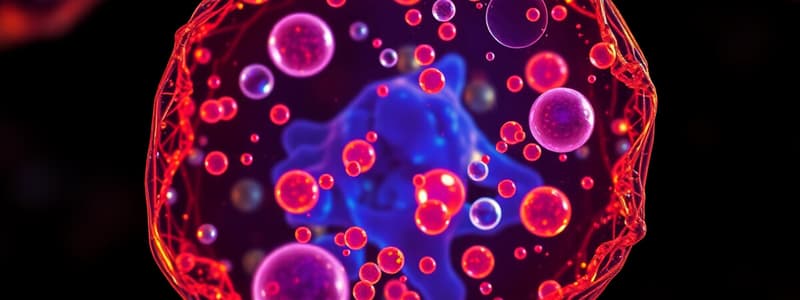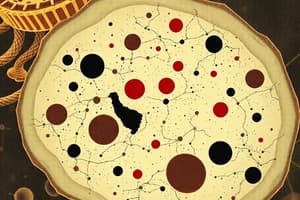Podcast
Questions and Answers
What role does the cytoplasm play in maintaining cell shape?
What role does the cytoplasm play in maintaining cell shape?
- It is responsible for synthesizing proteins.
- It helps to keep the organelles in place. (correct)
- It generates energy for cellular processes.
- It provides genetic information.
What is the primary function of the nucleolus?
What is the primary function of the nucleolus?
- Transport of enzymes
- Storage of genetic material
- Assembly of ribosomes (correct)
- Transcription of messenger RNA
Which of the following is NOT a function of cytoplasm?
Which of the following is NOT a function of cytoplasm?
- Respiration and energy production (correct)
- Storage of enzymes and materials
- Transport of organelles and inclusions
- Support and structure
Which of the following components is NOT a part of the nucleolus structure?
Which of the following components is NOT a part of the nucleolus structure?
How does the cytoplasm contribute to the protection of the cell?
How does the cytoplasm contribute to the protection of the cell?
What is the term used for the region of a chromosome that produces nucleolus?
What is the term used for the region of a chromosome that produces nucleolus?
What is cytoplasmic streaming?
What is cytoplasmic streaming?
In which stage of cell division does the nucleolus disappear?
In which stage of cell division does the nucleolus disappear?
Which substances does the cytoplasm store in plant cells?
Which substances does the cytoplasm store in plant cells?
What would likely occur if cytoplasm were absent from the cell?
What would likely occur if cytoplasm were absent from the cell?
Which type of cell is likely to contain a single large nucleolus relative to its volume?
Which type of cell is likely to contain a single large nucleolus relative to its volume?
What does the granular regions of the nucleolus contain?
What does the granular regions of the nucleolus contain?
Which function of cytoplasm aids in the transport of waste materials out of the cell?
Which function of cytoplasm aids in the transport of waste materials out of the cell?
The dense fibrillar component in the nucleolus is primarily responsible for which process?
The dense fibrillar component in the nucleolus is primarily responsible for which process?
Which component of the cytoplasm fills empty spaces within the cell?
Which component of the cytoplasm fills empty spaces within the cell?
How many nucleoli may typically be found in a nucleus?
How many nucleoli may typically be found in a nucleus?
What is the composition of the cytosol primarily made up of?
What is the composition of the cytosol primarily made up of?
Where is the cytoplasm located in a eukaryotic cell?
Where is the cytoplasm located in a eukaryotic cell?
What behavior does the cytoplasm exhibit when it acts like both a liquid and a solid?
What behavior does the cytoplasm exhibit when it acts like both a liquid and a solid?
What distinguishes the size of cytoplasm in different cells?
What distinguishes the size of cytoplasm in different cells?
What is the primary role of inclusion bodies found in the cytoplasm?
What is the primary role of inclusion bodies found in the cytoplasm?
Which of the following accurately describes the nuclear envelope?
Which of the following accurately describes the nuclear envelope?
How does the cytoplasm behave when it approaches the glass transition?
How does the cytoplasm behave when it approaches the glass transition?
Which of the following correctly represents the role of cytosolic components?
Which of the following correctly represents the role of cytosolic components?
What is the primary function of the nucleus in a eukaryotic cell?
What is the primary function of the nucleus in a eukaryotic cell?
Which statement about chromosome numbers in species is accurate?
Which statement about chromosome numbers in species is accurate?
What characteristic is true for the majority of eukaryotic cells?
What characteristic is true for the majority of eukaryotic cells?
Which of the following best describes the origin of replication?
Which of the following best describes the origin of replication?
Which feature is generally found in telomeres across different organisms?
Which feature is generally found in telomeres across different organisms?
What are nucleolar organizers identified as on the metaphase chromosomes?
What are nucleolar organizers identified as on the metaphase chromosomes?
Which of the following best describes euchromatin?
Which of the following best describes euchromatin?
What is the primary function of centromeres during cell division?
What is the primary function of centromeres during cell division?
Which term describes the highly condensed and transcriptionally silent regions of chromatin?
Which term describes the highly condensed and transcriptionally silent regions of chromatin?
How does the structure of chromatin differ from that of chromosomes?
How does the structure of chromatin differ from that of chromosomes?
What do telomeres provide at the ends of eukaryotic chromosomes?
What do telomeres provide at the ends of eukaryotic chromosomes?
What is a characteristic of a SAT-chromosome?
What is a characteristic of a SAT-chromosome?
Which of the following accurately defines the term 'chromosome'?
Which of the following accurately defines the term 'chromosome'?
Flashcards are hidden until you start studying
Study Notes
Cytoplasm Basics
- The cytoplasm is a gel-like substance found within the cell membrane.
- It is made up of cytosol, organelles, and inclusion bodies.
- In eukaryotic cells, the cytoplasm is between the cell membrane and the nuclear envelope.
- In prokaryotic cells, the cytoplasm is everything inside the cell membrane.
Theories on Physical Nature of Cytoplasm
- Cytoplasm behaves like a sol-gel, meaning it can act as both a liquid (sol) and a solid (gel).
- Cytoplasm can also exhibit glass-like behavior, holding solid components together.
Structural Features and Composition of Cytoplasm
- The watery component of the cytoplasm is called cytosol.
- Cytosol is mostly water with dissolved salts and ions.
Parts and Function of Cytoplasm: Cytosol
- Cytosol fills the spaces in the cell not occupied by organelles.
Parts and Function of Cytoplasm: Cell Organelles
- Organelles are membrane-bound structures with specific functions within the cell.
Parts and Function of Cytoplasm: Cytoplasmic Inclusions
- Inclusion bodies are non-living components of the cytoplasm. Examples include stored nutrients and pigments.
Overall Functions of Cytoplasm
- Supports cell structure and maintains shape.
- Keeps organelles in place.
- Protects the cell from damage.
- Serves as a storage unit for vital components.
- Transports organelles and inclusions throughout the cell.
### Cytoplasmic Streaming
- Cytoplasmic streaming is the movement of the cytoplasm within the cell.
- It is a transportation system to move components like organelles and nutrients.
Cell Organelles: Definition and Function
- Cell organelles are specialized structures within the cell that perform specific functions.
- They are essential for the cell's survival and proper functioning.
Nucleus
- The nucleus is a membrane-bound organelle that contains the cell's genetic material (DNA).
- Found in eukaryotic cells.
Parts and Function of Nucleus: Nuclear envelope and nuclear pores
- The nuclear envelope is a double membrane that surrounds the nucleus, regulating what enters and exits.
- Nuclear pores are openings in the nuclear envelope allowing for the transport of molecules between the nucleus and cytoplasm.
Parts and Function of Nucleus: Nuclear lamina and Nucleoplasm
- The nuclear lamina is a network of protein filaments that provide structural support to the nucleus.
- Nucleoplasm is the gel-like substance within the nucleus that houses the chromosomes, nucleolus, and other nuclear components.
Parts and Function of Nucleus: Nucleolus
- The nucleolus is a dense region within the nucleus where ribosomes are assembled.
- It is not membrane-bound and disappears during cell division.
Parts and Function of Nucleus: Chromatin and Chromosome
- Chromatin is the complex of DNA and proteins that make up chromosomes.
- Chromosomes are made up of condensed chromatin and are visible during cell division.
Parts and Function of Nucleus: Centromere
- The centromere is the constricted region of a chromosome where sister chromatids are attached.
Parts and Function of Nucleus: Telomere
- Telomeres are protective caps at the ends of chromosomes that prevent degradation of DNA.
Parts and Function of Nucleus: Origin of replication
- The origin of replication is a specific sequence on a chromosome where DNA replication is initiated.
Parts and Function of Nucleus: Chromosome number
- Each species has a characteristic number of chromosomes.
- Most eukaryotic cells are diploid, meaning they have two copies of each chromosome.
Functions of the Nucleus
- Stores genetic information.
- Controls gene expression.
- Facilitates DNA replication for cell division.
- Produces ribosomes for protein synthesis.
Studying That Suits You
Use AI to generate personalized quizzes and flashcards to suit your learning preferences.




